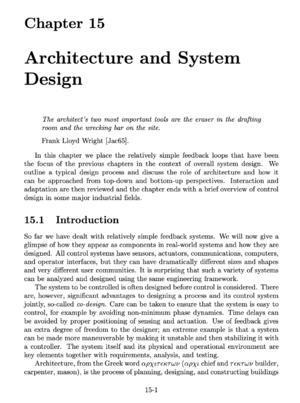Difference between revisions of "Architecture and System Design"
Jump to navigation
Jump to search
| (One intermediate revision by the same user not shown) | |||
| Line 1: | Line 1: | ||
{{Chapter | {{Chapter | ||
|Chapter number=15 | |Chapter number=15 | ||
| + | |Short name=architecture | ||
|Previous chapter=Fundamental Limits | |Previous chapter=Fundamental Limits | ||
|Next chapter=Bibliography | |Next chapter=Bibliography | ||
| − | |Chapter summary=In this chapter we place the relatively simple feedback loops that have been the focus of the previous chapters in the context of overall system design. We outline a typical design process and discuss the role of architecture and how it can be approached from top-down and bottom-up perspectives. Interaction and adaptation are then reviewed and the chapter ends with a brief overview of control design in some major industrial fields. | + | |Chapter summary=In this chapter we place the relatively simple feedback loops that have been the focus of the previous |First edition URL= |
| + | chapters in the context of overall system design. We outline a typical design process and discuss the role of architecture and how it can be approached from top-down and bottom-up perspectives. Interaction and adaptation are then reviewed and the chapter ends with a brief overview of control design in some major industrial fields. | ||
|Chapter contents=# Introduction | |Chapter contents=# Introduction | ||
# System and Control Design | # System and Control Design | ||
Latest revision as of 21:28, 28 August 2021
| Prev: Fundamental Limits | Chapter 15 - Architecture and System Design | Next: Bibliography |
In this chapter we place the relatively simple feedback loops that have been the focus of the previous
Contents
- Introduction
- System and Control Design
- Top-Down Architectures
- Layered Architectures for Control
- Online Optimization
- Discrete-decision making and supervisory control
- Linking Continuous and Discrete Controllers
- Model Checking and Program Synthesis
- Bottom-Up Architectures
- Cascade Control -- Several Sensors
- Mid-Range Control -- Many Actuators
- Selector Control -- Equipment Protection
- Internal Model Control -- Disturbance Observer
- The Smith Predictor -- Phase Advance
- Complementary Filtering -- Sensor Fusion
- Extremum Seeking or Self-Optimization
- Interaction
- The Relative Gain Array
- Parallel Systems
- Adaptation and Learning
- Adaptive Control
- Learning
- Neural Networks
- Deep Learning
- Control Design in Common Application Fields
- Aerospace -- High Performance Systems and Highly Skilled Users
- Automotive -- Complex Systems Used by Ordinary People
- Process Industry -- Complex Systems with Many Different Users
- Telecommunication -- Billions of Systems
- Further Reading
